Pontiac
Pontiac was a car brand owned, made, and sold by General Motors. Introduced as a companion make for GM's more expensive line of Oakland automobiles,[1] Pontiac overtook Oakland in popularity and supplanted its parent brand entirely by 1933.
 | |
| Division of General Motors | |
| Industry | Automotive |
| Fate | General Motors Chapter 11 reorganization |
| Founded | 1926 Pontiac, Michigan, United States |
| Defunct | October 31, 2010 |
| Headquarters | Detroit, Michigan, United States |
Key people | Semon "Bunkie" Knudsen John Z. DeLorean |
| Products | Automobiles |
| Parent | General Motors |
| Website | pontiac.com |
Sold in the United States, Canada, and Mexico by GM, Pontiac was advertised as the performance division of General Motors from the 1960s onward.[2] In the hierarchy of GM's five divisions, it slotted above Chevrolet, but below Oldsmobile, Buick, and Cadillac.
Amid late 2000s financial problems and restructuring efforts, GM announced in 2008 it would follow the same path with Pontiac as it had with Oldsmobile in 2004 and discontinued manufacturing and marketing vehicles under that brand by the end of 2010. The last Pontiac-badged cars were built in December 2009, with one final vehicle in January 2010. Franchise agreements for Pontiac dealers expired on October 31, 2010,[3] leaving GM to focus on its four remaining North American brands: Chevrolet, Buick, Cadillac, and GMC.
History
1926–1942

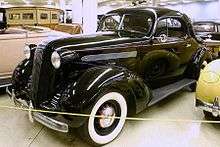
The Pontiac brand was introduced by General Motors in 1926 as the companion marque to GM's Oakland division, and shared the GM A platform. Purchased by General Motors in 1909, Oakland continued to produce modestly priced automobiles until 1931, when it was renamed Pontiac. It was named after the famous Ottawa chief, who had also given his name to the city of Pontiac, Michigan, where the car was produced.[4] Within months of its introduction, Pontiac was outselling Oakland, which was essentially a 1920s Chevrolet with a six-cylinder engine installed.[5] Body styles offered included a sedan with both two and four doors, Landau Coupe, with the Sport Phaeton, Sport Landau Sedan, Sport Cabriolet, and Sport Roadster. As a result of Pontiac's rising sales, versus Oakland's declining sales, Pontiac became the only companion marque to survive its parent, with Oakland ceasing production in 1932.
Pontiacs were also manufactured from knock-down kits at GM's short-lived Japanese factory at Osaka Assembly in Osaka, Japan, from 1927–1941.[6]

Pontiac produced cars offering 40 hp (30 kW; 41 PS), 186.7 cu in (3.1 L) (3.25x3.75 in, 82.5x95mm) L-head straight-six cylinder engines in the Pontiac Chief of 1927; its stroke was the shortest of any American car in the industry at the time. The Chief sold 39,000 units within six months of its appearance at the 1926 New York Auto Salon, hitting 76,742 at 12 months. The next year, it became the top-selling six in the U.S., ranking seventh in overall sales.[7] By 1933, it had moved up to producing the least expensive cars available with straight-eight engines. This was done by using many components from the six-cylinder Chevrolet Master, such as the body, but installing a large chrome strip on the top and center of the front hood Pontiac called the "Silver Streak". Only eight-cylinder engines were offered in 1933 and 1934, displacing 223.4 cubic inches for 77 hp. In the late 1930s, Pontiac used a Buick "torpedo" body for one of its models, just prior to its being used by Chevrolet, earning some media attention for the marque. An unusual feature of the "torpedo"-bodied exhibition car was that, with push of a button, the front half of the body would open showing the engine and the car's front seat interior.[8] A major change occurred in 1937 for Pontiac, with all models except the new station wagon now using the all-steel B-body shared with Oldsmobile, LaSalle, and small Buicks. A new stronger X frame had Hotchkiss drive using a two-part drive shaft. The eight-cylinder had a 122-inch (3,099 mm) wheelbase, while the six-cylinder had a 117-inch (2,972 mm) wheelbase.[9] Both engines had increased displacements, the six going to 222.7 cubic inches for 85 hp, the eight to 248.9 for 100 hp. In 1940 and '42, Pontiac was built on three different bodies. The "A" body with Chevrolet, the "B" body shared with Oldsmobile and Buick, and the "C" body shared with the large Oldsmobile, Buick, and the small Cadillac. The "C" body for 1940 was called the Torpedo. In 1941, all Pontiacs were called Torpedoes. On February 2, 1942, the last civilian Pontiac automobile was manufactured in the United States, as all automobile factories converted to military production.[10]
For an extended period of time—prewar through the early 1950s— Pontiacs were quiet, solid cars, but not especially powerful. They came with a flathead straight-eight engine, which were slightly less expensive to produce than the increasingly popular V8, but they were also heavier and longer. Additionally, the long crankshaft suffered from excessive flex, restricting straight-eights to a relatively low compression ratio with a modest redline. However, in this application, inexpensive (yet very quiet) flatheads were not a liability.
1946–1954

From 1946 to 1948, all Pontiac models were essentially 1942 models with minor changes. The Hydra-matic automatic transmission was introduced in 1948 and helped Pontiac sales grow even though their cars, Torpedoes and Streamliners, were quickly becoming out of date.
The first all-new Pontiac models appeared in 1949. They incorporated styling cues such as lower body lines and rear fenders that were integrated in the rear-end styling of the car.
Along with new styling came a new model. Continuing the Native American theme of Pontiac, the Chieftain line was introduced to replace the Torpedo. These were built on the GM B-body platform and featured different styling from the more conservative Streamliner. In 1950, the Catalina pillarless hardtop coupe was introduced as a "halo" model, much like the Chevrolet Bel Air of the same year.
In 1952, Pontiac discontinued the Streamliner and replaced it with additional models in the Chieftain line built on the GM A-body platform. This single model line continued until 1954 when the Star Chief was added. The Star Chief was created by adding an 11-inch (280 mm) extension to the A-body platform creating a 124-inch (3,100 mm) wheelbase.
The 1953 models were the first to have one-piece windshields instead of the normal two-piece units. While the 1953 and 1954 models were heavily reworked versions of the 1949-52 Chieftain models, they were engineered for the V8 engine that was supposed to be introduced on the 1953 models, but Buick division complained to corporate that the introduction might take sales away because Buick was introducing its new nailhead V-8 in 1953. The corporation held Pontiac back until 1955.
1955–1960


Completely new bodies and chassis were introduced for 1955. A new 173 hp (129 kW; 175 PS) overhead-valve V8 engine was introduced. (see Engines section below). Sales increased. With the introduction of this V8, the six-cylinder engines were discontinued; a six-cylinder would not return to the full-sized Pontiac line until the GM corporate downsizing of 1977. A four-cylinder engine was introduced in the Tempest model line in 1961, followed by an overhead-cam six-cylinder starting in 1966, as well as on the Firebird. It was the first popular-priced, mass-produced engine in America using an overhead-camshaft configuration.[11]
In 1956, when 42-year-old Semon "Bunkie" Knudsen became general manager of Pontiac, alongside new heads of engineering, E. M. Estes and John DeLorean, Knudsen immediately began reworking the brand's image. One of the first steps involved the removal of the famous trademark "silver streaks" from the hood and deck lid of the 1957 models just weeks before they were introduced. Another step was introducing the first Bonneville—a limited-edition Star Chief convertible that showcased Pontiac's first fuel-injected engine. About 630 Bonnevilles were built for 1957, each with a retail price of nearly $5,800. While new-car buyers could buy a Cadillac for that price, the Bonneville raised new interest in what Pontiac now called "America's No. 1 Road Car".

The following year, the Bonneville became its own line, built on the 122-inch (3,100 mm) wheelbase of the A-body platform. A 1958 Tri power Bonneville was the pace car for that year's Indianapolis 500. Also, 1958 was the last year Pontiac Motor Division would bear the "Indian" motif throughout the vehicle. The exception would be the Indian head high-beam indicator light in the instrument cluster. All 1958 models featured ball joint front suspension replacing the previous kingpin design.
With the 1959 model year, Pontiac came out with its "Arrowhead" emblem, with the star design in the middle. The "Arrowhead" design ran all the way up the hood from between the split grille, and on Star Chief models, had eight chrome stars from the emblem design bolted to both sides of the vehicle as chrome trim. Knudsen saw to it that the car received a completely reworked chassis, body, and interior styling. Quad headlamps, as well as a longer, lower body were some of the styling changes.
The Chieftain line was renamed Catalina; Star Chief was downgraded to replace the discontinued Super Chief series and for the first time did not have a two-door hardtop, only a two-door sedan along with a four-door hardtop and four-door sedan; in addition, there was no Star Chief wagon. The Bonneville was now the top of the line, coming in three body styles of two-door hardtop, four-door vista, and four-door wagon. The Star Chief's four-door "Vista" hardtop was also shared by the Bonneville. Catalina models included a two-door hardtop, two-door sedan, four-door sedan, four-door hardtop vista and two wagons, one a six-passenger and one a nine-passenger wagon. Bonneville and Star Chief were built on a 124-inch (3,100 mm) wheelbase with the exception of the Bonneville wagon and all Catalina models and Bonneville wagon that rode on a 122-inch wheelbase. Catalina was also seven inches shorter than Bonneville and Star Chief and weighed one hundred to two hundred pounds less than its long-wheelbase counterparts. All 1959 Pontiac engines were equipped with a 389-cubic-inch engine with horsepower ratings from 215 hp economy engine to a conservative rated 345 hp Tri power carbureted engine. All automatics were four-speed Super-Hydra-Matics or, as Hydramatic Division that designed and built them called them, "Controlled coupling HydraMatic". Oldsmobile used this same transmission and called it Jetaway HydraMatic; Cadillac also used it, and called it 315 or P 315 Hydramatic. A three-speed, column-mounted stick shift was standard on all Pontiacs. This coincided with major body styling changes across all models that introduced increased glass area, twin V-shaped fins, and lower hood profiles. Because of these changes, Motor Trend picked the entire Pontiac line as 1959 Car of the Year. The '59s have a five-inch (127 mm) wider track,[12] Front at 63 7/8" front track and 64.0" rear track because Knudsen noticed the new, wider bodies looked awkward on the carried-over 1958 frames. The new "Wide-Track" Pontiacs not only had improved styling, but also handled better—a bonus that tied into Pontiac's resurgence in the marketplace.
The 1960 models had a complete reskinning with the exception of the body's canopies, which remained identical to the '59s, but removed the tail fins and the distinctive split grille (which Ford copied on the final Edsel models for 1960). The 1960 models standard engine all had a power gain of 3 hp due to a compression bump of .25 to one over the '59 engine. The front track was now widened to the rear track at 64". Ventura was introduced, a more luxurious hardtop coupe and the Vista four-door hardtop now being built on the shorter 122-inch (3,100 mm) wheelbase platform, with it falling between the Catalina and Star Chief models. The Ventura featured the luxury features of the Bonneville in the shorter, lighter Catalina body.
1961–1970
Most of Pontiac's models built during the 1960s and '70s were either styled like, or were siblings to, other GM makes (except Cadillac). However, Pontiac retained its own front- and rear-end styling, interiors, and engines.
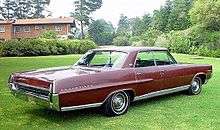
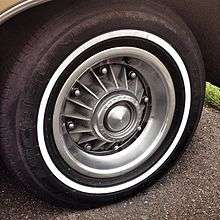
The 1961 models were similarly reworked. The split grille returned, as well as all-new bodies and a new design of a perimeter-frame chassis for all its full-sized models (something which would be adopted for all of GM's intermediate-sized cars in 1964, and all its full-sized cars in 1965). These new chassis allowed for reduced weight and smaller body sizes. The similarly styled Chevrolet still used the radically different "X" frame in the early 1960s.
A complete departure in 1961, though, was the new Tempest, one of the three Buick-Olds-Pontiac (BOP) "compacts" introduced that year, the others being the Buick Special and Skylark and Oldsmobile F-85 and Cutlass. Toward the end of the 1961 model year, an upscale version of the Tempest called the LeMans was introduced, named after the famous 24 Hours of Le Mans auto race in France.
All three were unibody cars, dubbed the Y-body platform, combining the frame and body into a single construction, making them comparatively lighter and smaller. All three put into production new technology pushed by John DeLorean, on which GM had been working for several years prior, but the Tempest was by far the most radical. A flexible steel shaft rotating at the speed of the engine delivered power from the front-mounted engine through a "torque tube" to a rear-mounted transaxle. This innovation not only delivered close to a 50/50 front-rear weight distribution that drastically improved handling, it also enabled four-wheel independent suspension, which enhanced it even more. It also all but eliminated the large floor "hump" common to front-engined, rear-drive cars.
Though the Tempest's transaxle was similar to the one in the Corvair, introduced the year before, it shared virtually no common parts. GM had planned to launch a Pontiac version of the Corvair (dubbed "Polaris"), but Bunkie Knudsen—whose niece had been seriously injured in a Corvair crash—successfully argued against the idea. The Polaris design apparently made it to full-scale clay before it was cancelled. Instead, DeLorean's "rope-shaft" design was green-lighted.
Contemporary rumors of the rope-shaft's demise due to reliability problems are unfounded; the rope-shaft's durability and performance had been proven in tests in full-sized Pontiacs and Cadillacs in 1959, and only adapted to a smaller car in 1960. The Tempest won the [Motor Trend "Car of the Year" award in 1961—for Pontiac, the second time in three years. DeLorean's vision has been further vindicated by the adoption of similar designs in a slew of modern high-performance cars, including the Porsche 928, 924, and 944, the Corvette C5, and the Aston Martin DB9.
Unless customers checked an option, the Tempest's power plant was a 194.5 CID inline slant-four cylinder motor, derived from the right bank of the venerable Pontiac 389 V8, enabling it to be run down the same production line as the 389, saving costs for both the car's customers and Pontiac. Pontiac engineers ran early tests of this motor by literally cutting off the left bank of pistons and adding counterweights to the crankshaft, and were surprised to find it easily maintained the heaviest Pontiacs at over 90 miles per hour (140 km/h). In production, the engine received a crankshaft designed for just four cylinders, but this did not completely solve its balance issues. The engine gained the nickname "Hay Baler" because of it tendency to kick violently, like the farm machine, when its timing was off.
The aforementioned Buick 215 V8, was ordered by less than 2% of its customers in the two years it was available, 1961 and 1962. Today, the 215 cars are among the most sought-after of all Tempests. In 1963, Pontiac replaced the 215 with a "new" 326, which was really a 336 with a bore of 3.78 and stroke of 3.75 (same stroke as the 389), an iron-block mill that had the same external dimensions and shared parts with the 389, but an altered, reduced bore. The car's body and suspension were also changed to be lower, longer, and wider. The response was that more than half of the 1963 Tempests and LeMans (separate lines for that one year only) were ordered with the V8, a trend that did not go unnoticed by management. The next year, the 326 became a true 326 with a new bore size of 3.72. The Tempest's popularity helped move Pontiac into third place among American car brands in 1962, a position Pontiac would hold through 1970. The Buick 215 V8 would remain in production for more than 35 years, being used by Britain's Rover Group after it had bought the rights to it. GM attempted to buy the rights back, but Rover wished, instead, to sell the engines directly.
In November 1961, Knudsen had moved to Chevrolet. Pete Estes now became general manager of Pontiac and Delorean was promoted to Pontiac chief engineer. Both continued Knudsen's work of making Pontiac a performance-car brand. Pontiac capitalized on the emerging trend toward sportier bucket-seat coupes in 1962 by introducing the Grand Prix, taking the place of the Ventura, which now became a trim option on the Catalina. Although GM officially ended factory support for all racing activities across all of its brands in January 1963, Pontiac continued to cater to performance-car enthusiasts by making larger engines with more power available across all model lines. For 1963, the Grand Prix received the same styling changes as other full-sized Pontiacs such as vertical headlights and crisper body lines, but also received its own squared-off roof line with a concave rear window, along with less chrome. This concave rear window was duplicated on all Tempest/LeMans four-door intermediates in 1964-1965.
For 1964, the Tempest and LeMans' transaxle design was dropped and the cars were redesigned under GM's new A-body platform - frame cars with a conventional front-engined, rear-wheel drive layout. The most important of these is the GTO, short for "Gran Turismo Omologato," the Italian for "Grand Touring, Homologated" used by Ferrari as a badge to announce a car's official qualification for racing. In spite of a GM unwritten edict against engines larger than 330 Ci in intermediate cars, DeLorean (with support from Jim Wangers from Pontiac's ad agency), came up with the idea to offer the GTO as an option package that included a 389 Ci engine rated at 325 or 348 horsepower (260 kW).
The entire Pontiac lineup was honored as Motor Trend's Car of the Year for 1965, the third time for Pontiac to receive such honors. The February 1965 issue of Motor Trend was almost entirely devoted to Pontiac's Car of the Year award and included feature stories on the division's marketing, styling, engineering and performance efforts along with road tests of several models.

Due to the popularity of the GTO option, it was split from being an option on the Tempest LeMans series to become the separate GTO series. On the technology front, 1966 saw the introduction of a completely new overhead camshaft 6-cylinder engine in the Tempest, and in an industry first, plastic grilles were used on several models.
The 1967 model year saw the introduction for the Pontiac Firebird pony car, a variant of the Chevrolet Camaro that was the brand's answer to the hot-selling Ford Mustang. Intermediate sized cars (Tempest, LeMans, GTO) were mildly face-lifted but all full size cars and GTO lost their Tri-Power engine option though it did get a larger 400 cubic-inch V8 that replaced the previous 389. Full-sized cars got a major facelift with rounder wasp-waisted body lines, a name change for the mid-line series from Star Chief to Executive and a one-year-only Grand Prix convertible. 1968 introduced the Endura 'rubber' front bumper on the GTO, the precursor to modern cars' integrated bumpers, and the first of a series "Ram Air" engines, which featured the induction of cold air to the carburetor(s) for more power, and took away some of the sting from deleting the famous Tri-Power multiple carburetion option from the engine line up. This Tri carburetor deletion came from the 14th floor of GM banning multiple carburetion and headed by GM president Ed Cole. The Ram Air V garnered much auto press publicity, but only a relative few were made available for sale. Full-sized cars and intermediates reverted from vertical to horizontal headlights while the sporty/performance 2+2 was dropped from the lineup.
For 1969, Pontiac moved the Grand Prix from the full-sized lineup into a G-body model of its own based on the A-body intermediate four-door modified from 116 inches to 118 inches wheelbase chassis, but with distinctive styling and long hood/short deck proportions to create yet another niche product – the intermediate-sized personal-luxury car that offered the luxury and styling of the higher priced personal cars such as the Buick Riviera and Ford Thunderbird and the old Grand Prix and Olds Starfire but for a much lower price tag. Pete Estes, who like Knudsen had moved to be general manager of Chevrolet in 1966 and Delorean, general manager of the Pontiac division, needed a car to take the place of the sagging sales of the full size Grand Prix, but the development cost of the car was too much of burden for Pontiac division alone, so Delorean went to his old boss at Chevrolet to gather support for the development cost of the new "G" body Grand Prix. Estes agreed to share in the cost and allow Pontiac to have a one-year exclusivity on this new car, the next year Chevy would follow with its version which was called Chevrolet Monte Carlo. The new Grand Prix was such a sales success in 1969 as dealers moved 112,000 units - more than four times the number of Grand Prixs sold in 1968. Full-sized Pontiacs were also substantially restyled but retained the same basic under-body structure and chassis that debuted with the 1965 model - in fact the roof-lines for the four-door pillared sedans and Safari wagons were the same as the 1965 models, while the two-door semi-fastback design gave way to a squared-off notch-back style and four-door hardtop sedans were also more squared off than 1967-68 models. The GTOs and Firebirds received the Ram Air options, the GTO saw the addition of the "Judge" performance/appearance package, and the Firebird also got the "Trans Am" package. Although originally conceived as a 303 cubic inch model to compete directly in the Trans Am racing series, in a cost-saving move the Pontiac Trans Am debuted with the standard 400-cubic-inch performance engines. This year also saw De Lorean leaving the post of general manager to accept a similar position at GM's Chevrolet division. His replacement was F. James McDonald.
Pontiacs built in the late 1960s conformed to new U.S. Federal Motor Vehicle Safety Standards. These included energy-absorbing interior parts such as steering columns, steering wheels, knobs and handles, dual-circuit hydraulic brake systems, shoulder belts, side marker lights, and headrests.
The 1969 Firebirds received a heavy facelift but otherwise continued much the same as the original 1967 model. It was the final year for the overhead cam six-cylinder engine in Firebirds and intermediates, and the Firebird convertible (until 1991). Production of the 1969 Firebirds was extended into the first three months of the 1970 model year (all other 1970 Pontiacs debuted September 18, 1969) due to a decision to delay the introduction of an all-new 1970 Firebird (and Chevrolet Camaro) until February 26, 1970.
In addition in the late-1960s, GM directed their GM and Pontiac divisions to develop concept mini-cars called commuter car for urban drivers. GM developed a gasoline-electric drive hybrid the XP-833 and the Pontiac X-4 a rear-wheel drive mid-engine car that was powered by a radical X-shaped aircraft type air-cooled two-stroke radial engine where the standard crankshaft was replaced by a unit called a Scotch yoke. While the GM car was fully tested the Pontiac concept was not. Neither was placed in production.[13]
1970–1982
Increasing insurance and fuel costs for owners coupled with looming Federal emissions and safety regulations would eventually put an end to the unrestricted, powerful engines of the 1960s. Safety, luxury, and economy would become the new watch-words of this decade. Engine performance began declining in 1971 when GM issued a corporate edict mandating that all engines be capable of using lower-octane unleaded gasoline, which led to dramatic drops in compression ratios, along with performance and fuel economy. This, coupled with trying to build cars as plush as GM's more luxurious Buicks and Oldsmobiles, contributed to the start of a slow decline of Pontiac in 1971.[14]
In mid-1971 Pontiac introduced the compact, budget-priced Ventura II (based on the third generation Chevrolet Nova). This same year, Pontiac completely restyled its full-sized cars, moved the Bonneville, and replaced it with a higher luxury model named the Grand Ville, while Safari wagons got a new clamshell tailgate that lowered into the body while the rear window raised into the roof. 1971–1976 model full-size station wagons featured a 'Clamshell' design where the rear power-operated glass slid up into the roof as the tailgate (manually or with power assist), dropped below the load floor. The power tailgate, the first in station wagon history, ultimately supplanted the manual tailgate, which required marked effort to lift from storage.
The 1972 models saw the first wave of emissions reduction and safety equipment and updates. GTO was a now sub-series of the LeMans series. The Tempest, was dropped, after being renamed 'T-37' and 'GT-37' for 1971. The base 1972 mid-sized Pontiac was now called LeMans. James MacDonald left the post of general manager to be replaced by Martin J. Caserio in late 1972. Caserio was the first manager in over a decade to be more focused on marketing and sales than on performance.
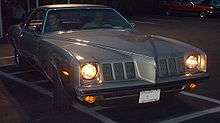
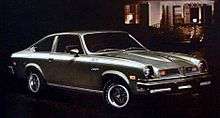
For 1973, Pontiac restyled its personal-luxury Grand Prix, mid-sized LeMans and compact Ventura models and introduced the all-new Grand Am as part of the LeMans line. All other models including the big cars and Firebirds received only minor updates. Again, power dropped across all engines as more emissions requirements came into effect. The 1973 Firebird Trans Am's factory applied hood decal, a John Schinella restylized interpretation of the Native American fire bird, took up most of the available space on the hood. Also in 1973, the new Super Duty 455 engine ("Super Duty" harkening back to Pontiac's Racing Engines) was introduced. Although it was originally supposed to be available in GTOs and Firebirds, only a few SD 455 engines made it into Firebird Trans Ams that year. One so equipped was tested by 'Car and Driver' magazine, who proclaimed it the last of the fast cars. But the pendulum had swung, and the SD 455 only hung on one more year in the Trans Am.
All Federal emissions and safety regulations were required to be in full effect for 1974 causing the demise of two of the three iterations of the big 455 cubic inch engines after this year. The last version of the 455 would hang on for two more years before being discontinued.
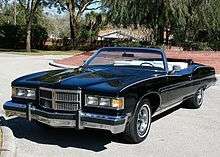
For 1975, Pontiac introduced the new sub-compact Astre, a version of the Chevrolet Vega. This was the brand's entry into the fuel economy segment of the market. Astre had been sold exclusively in Canada from 1973. It was offered through the 1977 model year. 1975 would also see the end of Pontiac convertibles for the next decade.
The 1976 models were the last of the traditional American large cars powered by mostly big block V8 engines. After this year, all GM models would go through "downsizing" and shrink in length, width, weight and available engine size. The 1976 Sunbird, based on the Chevrolet Vega and Monza's equivalent, joined the line. It was first offered as a Notchback, with a Hatchback body style added in 1977. The Vega Wagon body style was added in 1978, Sunbird Safari Wagon, replacing the Astre Safari Wagon. The Sunbird was offered in its rear-wheel-drive configuration through the 1980 model year. (Sunbird Safari wagon through 1979.)
At mid-year 1977, Pontiac introduced the Phoenix, an upscale version of the Ventura which replaced the Ventura entirely after the end of the 1977 model year. Pontiac also introduced its 151 cubic inch "Iron Duke" 4-cylinder overhead valve engine. It was first used in the 1977 Astre, replacing Astre's aluminum-block 140 cubic inch Vega engine. The 'Iron Duke' engine would later go into many GM and non-GM automobiles into the early 1990s. The 151 cubic inch L4 and the 301 cubic inch V8 were the last two engines designed solely by Pontiac. Subsequent engine design would be accomplished by one central office with all designs being shared by each brand.
For model year 1977, the full sized Pontiacs received the same "downsizing" as GM's other "B" body cars. The new Bonnevilles and Catalinas continued to be best-sellers, although their styling similarity to the Chevrolet Caprice was seen by some buyers as a "cheapening" of Pontiac's image. In 1981, the full-size Bonneville was discontinued, the name reassigned to the "A" body intermediate platform. That left the Catalina as the only big Pontiac, further reducing sales as buyers went for more plushness.
The remainder of the 1970s and the early 1980s saw the continued rise of luxury, safety and economy as the key selling points in Pontiac products. Wire-spoked wheel covers returned for the first time since the 1930s. More station wagons than ever were being offered. Padded vinyl roofs were options on almost every model. Rear-wheel drive began its slow demise with the introduction of the first front-wheel drive Pontiac, the 1980 Phoenix (a version of the Chevrolet Citation). The Firebird continued to fly high on the success of the 'Smokey and the Bandit' film, still offering Formula and Trans Am packages, plus a Pontiac first- a turbocharged V8, for the 1980 and 1981 model years. In addition to this, The Rockford Files, which lasted for 6 years used a Firebird Esprit 400 in its first season. James Garner was given a new model each year so for the second season (and remaining seasons), Firebird Formulas (mostly 400 cu in models) were used but only after they were stripped of their Formula twin scoop hood (replaced with a standard Firebird hood), rear trunk spoiler (holes filled) and Formula emblems/decals which created the appearance of a Firebird Esprit. Then the entire car was repainted in the official Rockford (Lt. Topaz) color for consistency and continuity throughout the series. Only the first season (1974) Firebirds were true Esprit 400's (2 bbl version) as well as wearing the factory Denver Gold Poly. When the 79-81 styling changed (front and rear fascia), James Garner was not pleased with the appearance and insisted the previous 1978 Firebirds remain throughout the remainder of the series. The turn which he performed throughout the show as well as most of the other driving stunts were his own and came to be known as the Rockford turn or J turn.
1982–1988

Introduced in 1982, the wedge shaped Firebird was the first major redesign of the venerable pony car since 1970. Partly due to the hugely successful NBC television series Knight Rider, it was an instant success and provided Pontiac with a foundation on which to build successively more performance oriented models over the next decade. The Trans Am also set a production aerodynamic mark of .32 cd. The next step in Pontiac's resurgence came in the form of its first convertible in nine years. GM adapted the J-body cars and the all-new for 1982 J2000 (later renamed Sunbird) had a convertible as part of its line.

Next, the 1984 Fiero came. This was a major departure from anything Pontiac had produced in the past. A two-seat, mid-engined coupe, the Fiero was targeted straight at the same market that Semon Knudsen had been aiming for in the late 1950s: the young, affluent buyer who wanted sporting performance at a reasonable price. The Fiero was also an instant success and was partially responsible for Pontiac seeing its first increase in sales in four years. Pontiac also began to focus on technology. In 1984, a Special Touring Edition (STE) was added to the 6000 line as a competitor to European road cars such as the Mercedes 190. The STE sported digital instruments and other electronics as well as a more powerful V-6 and retuned suspension. Later iterations would see some of the first introductions on Pontiacs of anti-lock brakes, steering wheel mounted radio controls and other advanced features. Full-size buyers, disappointed by the lack of an available big Bonneville, complained, resulting in Pontiac's importing the Canadian-market Pontiac Parisienne, which featured the Bonneville's deluxe trim. This car, although a Pontiac in name, was no more than a slightly re-trimmed Caprice. Despite this fact, the Parisienne sold in profitable numbers and this car continued in production until 1986 for the sedan, and 1989 for the Safari station wagon.With the exception of the Parisienne Safari, the Firebird and Fiero, beginning in 1988 all Pontiacs, with the exception of the Firebird, switched to front-wheel drive platforms. For the first time since 1970, Pontiac was the number three domestic car maker in America. Pontiac's drive to bring in more youthful buyers was working as the median age of Pontiac owners dropped from 46 in 1981 to 38 in 1988.
1989–1997

During this time, becoming standard on Pontiacs were: anti-lock brakes, GM's Quad-4 engine, airbags, and composite materials. In 1989, there was the end of Safari wagon production, thus it was the last V8 powered full sized rear wheel drive Pontiac until the 2009 G8. The 1990 model year saw the launch of Pontiac's first minivan and light truck, the Trans Sport. In addition, the Grand Prix line added its first ever 4-door model, offered in LE and STE trims. At the end of the 1991 model year, the 6000 was discontinued in favor of the newly expanded Grand Prix line up and the new Trans Sport minivan, which replaced the 6000 station wagon. In 1992, a brand-new Bonneville was introduced. This full-size model featured aerodynamic styling, large expanses of curved glass, front-wheel drive, and the 3800 Series I V6 as standard equipment. A new sub model, the SSEi, was introduced in 1992 carrying all standard equipment from the SSE model, plus the 205 hp supercharged 3800 V6. For 1993 the Bonneville added a new option package (H4U) called the Sport Luxury Edition (SLE), which was available on the SE model. This package included leather bucket seats, specific grille, side trim, exhaust, dash trim, lace alloy wheels, as well as a spoiler, sport handling and suspension systems and anti lock brakes. An all new Firebird was introduced in 1993. It was powered by either a 3.4 L V6 with 160 hp (120 kW), or in Trans Am guise a 275 hp (205 kW) LT-1, a 5.7 L (350c.i.) V8, and could be backed by a T-56 six-speed manual.The Sunbird was replaced with the (still J-body) Sunfire in 1995. While a V6 engine was no longer available in the J-car, sedan, coupe, and convertible body styles did survive. For 1996 the Bonneville received updated front and rear fascias along with several other enhancements. The 3800 Series II V6 had become standard in 1995, featuring 200 hp. The updated supercharged 3800 Series II now featured 240 hp.
Division Sales Figures[15]
| Year | Sales |
|---|---|
| 1989 | 801,600 |
| 1990 | 636,390 |
| 1991 | 518,598 |
| 1992 | 519,925 |
| 1993 | 533,776 |
| 1994 | 577,022 |
| 1995 | 589,192 |
| 1996 | 479,973 |
| 1997 | 563,897 |
1997–2004

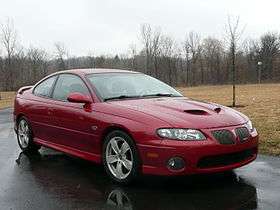
1996 was the last year for the 5th-generation Grand Prix. The Grand Prix debuted in 1997 with the "Wider is Better" advertising campaign. The GTP trim level was added to the Grand Prix. It featured a supercharged 3.8 L V6 rated at 240 hp (180 kW) and 280 lb⋅ft (380 N⋅m) of torque. One design highlight of this generation Grand Prix is the sharing of the roof's sheet metal between both coupe and sedan models.
In 1998 the Firebird was updated. The TransAm received the LS-1 motor which produced 305 hp (227 kW). The WS6 option saw this number increase to 320 hp (240 kW) and the addition of Ram Air and stiffer springs.The 1999 model year saw the replacement of the Trans Sport with the larger Montana minivan.
In 2000, the Bonneville got its first major redesign since 1992 and was based on the G-Body, shared with the Oldsmobile Aurora and Buick LeSabre. In 2001 Pontiac introduced the polarizing proto-crossover Aztek. In 2002, both the Firebird/Trans Am and Camaro were discontinued as a result of declining sales and a saturated sport market. The coupe version of the Grand Prix was also discontinued. The 2003 Vibe arrived in spring 2002, a Toyota-based compact wagon built at the NUMMI joint-venture plant. Also, in 2003, it was announced that the Grand Prix would be in its last year of its generation, with an improved 7th generation on the way for 2004. It would also be Pontiac's final year in NASCAR. Pontiac's final victory in NASCAR would be achieved by Ricky Craven in one of the closest finishes in NASCAR history. A few surplus Pontiacs continued running in the Busch Series through 2005, in the ARCA Racing Series as late as 2007, and with factory support in the NASCAR Canadian Tire Series from 2007 to 2009; as of 2019, a Pontiac-engined car runs part-time in the NASCAR Whelen Modified Tour, and Pontiac cars can still be found in local and regional stock car leagues.
2004 saw the reintroduction of the Pontiac GTO (based on the Australian-developed Holden Monaro). The GTO was also initially powered by the 350 HP LS-1 V8 in its first model year. It had an independent front and rear suspension and an upscale full leather interior. Sales did not reach the 18,000 units that GM predicted. The LS1 engine was retired in 2004. Pontiac added the drive-by-wire 400 HP LS2 V8 for 2005–2006 model years at no additional cost. Additional upgrades also consisted of stainless steel dual exhaust outlets, larger Corvette sourced PBR brakes with EBD, larger front vented rotors with vented rear rotors, and functional heat extractor hood scoops. The Bonneville introduced the GXP trim level to replace the SSEi. The Bonneville GXP featured a 4.6 Northstar V8, borrowed from Cadillac, and replaced the Supercharged 3800 Series II. The redesigned Grand Prix made its appearance, and featured a GT and GTP trim level. The GTP's new 3.8 L supercharged V6 now made 260 horsepower (190 kW), up 20 from the previous generation. TAPshift was also introduced as well as a Competition Group package (Comp G).
2005–2010
Pontiac went through a complete product revamping through this period. The Grand Am was replaced with the mid-size G6 in 2004. The Grand Am coupe was produced for the 2005 model year to fill the gap until the new G6 coupe and convertible became available for the 2006 model year.The Bonneville ended production in 2005 after nearly 50 years of production. Although it was not directly replaced, the RWD G8 introduced for the 2009 model year did fill some of the market void.The Solstice concept shown in 2002 was approved for production as a roadster (2006-2009) and, for a few months, a hard-top coupe (2009), which is considered to be quite rare, as a total of only 1,266 coupes made it off the assembly line in Wilmington, DE before it was shut down due to the demise of Pontiac. This is in stark contrast to the over 64,000 Solstice Convertibles that were manufactured on that same line.The controversial and slow-selling Aztek was finally phased out and replaced by the Torrent, which was identical to the Chevrolet Equinox. In 2005 the Sunfire was discontinued and replaced by the new Pontiac Pursuit (later named G5 for the American market). Initially, Pontiac did not plan on offering the G5 in the United States, however dealer pressure to fill the gap left by the discontinuation of the Sunfire caused Pontiac to introduce only the coupe variation into the U.S. The 4 door sedan was available in Canada as the Pursuit throughout the model run. The high-performance GXP trim was introduced in the Grand Prix line in 2005, adding GM's LS4 V8 engine that produced 303 horsepower and 323 lb. ft. of torque. This engine was built to give buyers a V8 sedan option until the all-new G8 arrived in 2008. In 2008, the Grand Prix ended production and the launch of the Australian-built RWD G8 commenced. The G8 gained positive reception for its high performance and low costs. Many noted the G8 as the poor man's BMW M5, due to similar performance at a much cheaper price.[16] The G8 GXP was the most powerful production car Pontiac had ever built, and is widely regarded as the best driver's car ever to wear the Pontiac badge. The Holden Ute was scheduled to be launched as the G8 ST before it was cancelled in January 2009 due to GM's financial situation. It was later announced that the G8 may not see a second generation.Towards the end of the decade many rumors began spreading that Pontiac would become completely reliant on RWD. Reports ranged from a compact sedan based on the Alpha platform to a new RWD G6 for the 2013 model year. Many reports suggested that the Trans Am/Firebird would return after GM confirmed the rebirth of the Camaro, however, no reports confirmed this.
On December 2, 2008, General Motors announced that it was considering eliminating numerous brands, including Pontiac, in order to appease Congress in hope of receiving a $25 billion loan.[17] On February 17, 2009, GM proposed the elimination of its Saturn division, the sale of Saab, and either the sale or elimination of Hummer, depending on whether a buyer could be found quickly. GM clarified that Pontiac would have begun to focus on "niche" models aimed at the "youthful and sporty" segment, but did not provide specifics. Pontiac was to trim its number of models to four,[18] although there was talk of retaining only one model.[19] By April 2009 several automotive websites and business publications were reporting that GM was doing a study suggesting it might eliminate the brand altogether, along with sister truck brand GMC.[20][21][22] On April 23 a report was published[23] stating the company would be dropping the Pontiac brand while preserving the GMC truck line, and the Chevrolet, Cadillac, and Buick brands. The decision to eliminate Pontiac was made primarily due to the increasing threat of a bankruptcy filing if the June 1 deadline could not be met.[24] On April 27, 2009, GM announced that Pontiac would be dropped and that all of its remaining models would be phased out by the end of 2010.[25] Though both production and franchise agreements ended in 2010, Pontiac remains a registered and active trademark of GM.[26][27]
General Motors would eliminate an additional 7,000 to 8,000 factory jobs in the United States and shed 2,600 dealers by 2010 under a revised business plan. GM Chief Executive Officer Fritz Henderson said the Pontiac brand would be closed by 2010, calling it an “extremely personal decision”. In addition to speeding up decisions on Saturn, Saab and Hummer, GM would be left with four brands—Chevrolet, Buick, GMC and Cadillac.[28]
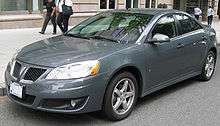
In early May 2009, Jim Waldron, a Davison, Michigan, Pontiac dealer, announced that he was interested in purchasing the Pontiac brand and logos, and had found financing to purchase them and some soon-to-be shuttered GM plants in order to build cars. However, GM had already decided to retire the brand as it has begun to sell off its remaining inventory and said that, unlike Saturn, Hummer, and Saab, Pontiac was not for sale.[29]
The Pontiac brand was pulled after the 2009 model year in Mexico and the brand was renamed Matiz, selling only one vehicle, the Matiz G2 (Matiz's logo is similar to Pontiac's).
The last Pontiac, a white 2010 model year G6 4 door sedan, was built at the Orion Township Assembly Line in January 2010.[30]
Pontiac became the second brand General Motors had eliminated in six years. Oldsmobile met the same fate in 2004 after being more slowly phased out over four years. Pontiac also became the ninth North American automobile brand since 1987 to be phased out, after Merkur, Mercury, Passport, Asüna, Geo, Plymouth, American Motors (AMC) (renamed Eagle in 1988, and phased out in 1999), and Oldsmobile.
Style trademarks and logo

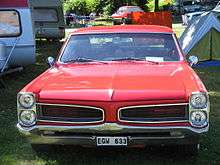
A Native American headdress was used as a logo until 1956. This was updated to the Native American red arrowhead design for 1957 in all usage except the high-beam indicator lamp, which retained the original logo through 1970. The arrowhead logo is also known as the Dart.
Besides the logo, another identifying feature of Pontiacs were their "Silver Streaks"—one or more narrow strips of stainless steel which extended from the grille down the center of the hood. Eventually they extended from the rear window to the rear bumper as well, and finally; along the tops of the fins. Although initially a single band, this stylistic trademark doubled to two for 1955-1956. The Streaks were discontinued the same year as the Indian Head emblems (1957).

One long-familiar styling element was the split-grille design which was introduced in 1959 to complement the make's new "wide track" stance. The 1960 models, however, reverted to the full-width grille styling. The split-grille then returned for the 1961 model year and would remain as the marque's trademark. Other styling cues were the pointed "arrowhead" nose (in the 1960s and 1970s), and "grilled-over" (in the 1960s), or multiple horizontal-striped taillights. This later feature originated with the 1963 Grand Prix, and although the 1962 Grand Prix also had rear grillework, the taillight lenses were not behind it. Less longstanding but equally memorable is the "cladding" common on the doors and fenders of Pontiacs produced in the 1990s and 2000s. Rather than minimizing the side bumper, Pontiac designers put two troughs going along the length. Bumpers with this appearance were found on nearly all Pontiacs until the arrival of the G6. From 2004 onwards, new Pontiacs had cleaner, more premium styling, but retained the traditional split grille.
Canadian/export models
Pontiacs were built in Canada by Canadians GM Canada with Canadian raw materials beginning in 1926, with factories in Oshawa, Ontario and Regina, Saskatchewan. The models they produced were largely the same as their US built counterparts. Canadian cars had Canadian oak in the bodies, not peach wood like the US cars. The first significantly different model was the "224", introduced in 1937 with a Canadian-built 224 in3 (3.7 L) version of the then-new Chevrolet straight-six. After 1940 the 239 in3 (3.9 L) Pontiac Flathead Six was used, but otherwise the cars shared chassis and body parts with the Chevrolets as a measure to reduce the cost of production for the relatively small Canadian market.
After the Second World War the Pontiac brand continued to be very popular, and the product line was further harmonized with the Canadian Chevrolet products. In the late 1940s and early 1950s the US market embraced eight-cylinder engines and US Pontiacs equipped with the straight-eight engine were popular, but in Canada the straight-six continued to be the popular offering. Beginning in 1953 the model lineup consisted of the base "Pathfinder", mid-range "Pathfinder Deluxe", and top-of-the-line "Laurentian". The chassis was shared with the Chevrolet, and interiors were a combination of Chevy and Pontiac parts.
By 1955 the US and Canadian Pontiac lines had diverged almost completely, with the US models positioned as "mid-market" cars available exclusively with the new 287 in3 (4.7 L) Pontiac V8, while in Canada the brand was still positioned as an entry-level marque. The Canadian dealership lines were either Chevrolet-Oldsmobile-Cadillac or Pontiac-Buick-GMC; small towns usually had only one or the other, but not both, so it was imperative to keep Pontiac prices competitive with Plymouth and Ford (and Chevrolet). Producing two entirely separate engine series would have increased costs, so the 261 in3 (4.3 L) Chevrolet straight-six replaced the Pontiac Flathead Six, and the new 265 in3 (4.3 L) Chevrolet V8 replaced the old Pontiac straight-eight.
In 1958 the "Strato-Chief" replaced the "Pathfinder Deluxe", and in 1959 the line was reorganized with the new "Parisienne" inserted at the top (similar to the US market Bonneville). Even after the Canadian market was opened by the signing of the 1965 Autopact the Canadian full-sized Pontiac lineup—and the practice of building them on Chevrolet chassis with Chevrolet engines—continued mostly unchanged into the 1980s (although the Strato-Chief was dropped in 1970).
GM Canada also built right-hand drive versions of their Pontiacs for export to Australia, New Zealand and South Africa as knock-down kits until the late 1960s. The interiors of these cars more closely resembled the equivalent Chevrolets than the Canadian market cars did, as the Chevys had already been designed for right-hand drive.
When the compact Chevrolet Corvair and Pontiac Tempest were introduced in 1960 the Corvair was built in Canada, but the Tempest was not. Importing the Tempest into Canada from the United States was not a viable option as the duties that would have had to have been paid would have substantially increased the price of what was supposed to be the least-expensive Pontiac. Tentative plans to build a Pontiac version of the Corvair were scrapped when the more conventional Chevy II was introduced in late-1961. GM Canada created an entirely new brand exclusively for the Canadian market for their rebadged Chevy IIs: Acadian. Acadians were sold alongside the rest of the Pontiac lineup at Pontiac-Buick-GMC dealerships until 1971. When the mid-sized Chevrolet Chevelle was introduced in 1964 it was sold in Canada as the Acadian Beaumont ('Beaumont' was formerly the top-level trim of Chevy II-based Acadian), and in 1966 Beaumont became its own marque. The Beaumont-badged Chevelles were in production in Canada until 1969.
Even after the 1965 Autopact (and Canada–United States Free Trade Agreement that replaced it in 1988) the practice of building Pontiac-badged Chevrolets for sale at Canadian dealers continued until the brand was discontinued in 2010. Such cars include the Astre (based on the Vega), the Acadian (based on the Chevette), the Sunburst (based on the Spectrum), the Firefly (based on the Sprint), the Tempest (based on the Corsica), the Sunrunner (based on the Tracker), the Pursuit (based on the Cobalt; later badged as the "G5 Pursuit" and simply "G5"), and the Wave (based on the Aveo; later badged the "G3 Wave" and "G3").
Engines
Pontiac engineer Clayton Leach designed the stamped steel valvetrain rocker arm, a simplified and reliable alternative to a bearing-equipped rocker. This design was subsequently picked up by nearly every OHV engine manufacturer at one point or another.
Pontiac began work on a V8 configuration in 1946. This was initially intended to be an L-head engine, and 8 experimental units were built and extensively tested by the end of the 1940s. But testing comparisons to the OHV Oldsmobile V8 revealed the L-head could not compete performance-wise. So, in addition to building a new Pontiac Engineering building in 1949–1951, the decision to re-direct the V8 to an OHV design delayed its introduction until the 1953 model year, however the Buick division was introducing its new engine (Nailhead V-8) in 1953 and asked the corporation to hold back or delay Pontiac's V-8 introduction until the 1955 model year which it did.
In mid-1956, Pontiac introduced a higher-powered version of its V8. Among other things, this version of the engine was equipped with a high-performance racing camshaft and dual 4-barrel carburetors. This was the first in a series of NASCAR-ready pre- Super-Duty V8 engines and introduced the long line of multi-carburetor equipped engines that saw Pontiac become a major player during the muscle car and pony car era of the 1960s. The enlarged 1956 Pontiac V8 found its way into light-duty GMC pickup trucks.
Pontiac's second generation V8 engines shared numerous similarities, allowing many parts to interchange from its advent in 1959 to its demise in 1979. Sizes ranged from 287 cubic inch to 455 cubic inch. This similarity (except the 301 & 265) makes rebuilding these engines relatively easier. This feature also made it possible for Pontiac to invent the modern muscle car, by the relatively simple process of placing its second largest-displacement engine, the 389 cid, into its mid-size car, the Le Mans, creating the Pontiac LeMans GTO.
From their inception in the 1950s until the early 1970s, Pontiac engines were known for their performance. The largest engine was a massive 455 cubic inch V8 that was available in most of their mid-size, full-size and sports car models. At the height of the horsepower era, Pontiac engines reached a powerful 390 rated horsepower (SAE gross), though other engines achieved considerably higher outputs in actuality. Federal emissions laws eventually brought the horsepower era to a close and resulted in a steady decline for Pontiac's engines. One holdout to this industry-wide slide was the Super Duty 455 engine of 1973–1974. Available only in the Firebird Formula and Trans Am models, this was rated at 310 hp (230 kW) net initially but after having issues passing EPA emissions tests, the camshaft was changed to the old RA III cam and with the change, came a 290 hp (220 kW) net rating. The engine was the pinnacle of Pontiac engine development and was a very strong performer that included a few race-specific features, such as provisions for dry-sump oiling. This engine and its legacy drive the SD Trans Ams and Formulas as one of the more, if not the most, desirable Pontiacs ever produced.
The only non-traditional Pontiac V8 engines were the 301 cubic inch and the smaller displacement 265 cubic inch V8s. Produced from 1977 through 1981, these engines had the distinction of being the last V8s produced by Pontiac; GM merged its various brands' engines into one collectively shared group in 1980, entitled General Motors Powertrain. The 301 had a 4-inch (100 mm) bore and 3-inch (76 mm) stroke, identical to the vaunted Chevrolet small-block engine and Ford Boss 302 engine.
Pontiac engines were not available in Canada, however, but were replaced with Chevrolet engines of similar size and power, resulting in such models as the Beaumont SD-396 with a Chevrolet big-block 396 cubic inch V8.
Carburetors
PMD used Carter 1-barrel carburetors for many years but, by the time of the second generation, the V8 engines had switched mostly to 2-barrel offerings. These also were the basis for the Tri-Power setups on the engines.
The Tri-Power setup included one center carburetor with idle control and two end carburetors that did not contribute until the throttle was opened more than half way. This was accomplished two ways, mechanically for the manual transmission models, and via a vacuum-switch on the automatics. This went through various permutations as it was only a factory installed option in from 1957-1966.
PMD also had a square-bore 4-barrel at the time, but this was rated at a lower power than the Tri-Power. This carburetor was later replaced by the Quadrajet, a spread bore. The term "Spread-bore" signifies the difference in sizes between the primaries and secondaries, using smaller primaries paired with larger secondaries for increased airflow at wider throttle with fuel delivery changes akin to the two-plus-four benefit of Tri-Power but with a single carburetor. The Q jet was not the only thing that gave the top GTO 400" engine and the 428 H-O engines the same horsepower as the 389 and 421. Aside of the displacement advantage, the new engine had redesigned cylinder heads with different valve angles and larger ports. The different valve angles allowed for larger diameter intake and exhaust valves. There have been many test when a Tri-Power set-up was added to a 400" or 428" engine that they made even more horsepower than a Q-Jet.
By the end of the muscle car era, the Quadrajet setup had become the nearly ubiquitous choice on PMD engines. The Quadrajet design continued until 1990 for Oldsmobile V8 applications, with added computer controls to meet emissions and fuel economy standards.
Models
- Pontiac 2+2 (1964–1970)
- Pontiac 1000 (1983–1987)
- Pontiac 2000 (1983)
- Pontiac 2000 Sunbird (1983–1984)
- Pontiac 6000 (1982–1991)
- Pontiac Acadian (1976–1987, rebadged Chevrolet Chevette/Pontiac T1000/1000, Canada)
- Pontiac Astre (1975–1977; 1973–1977 Canada)
- Pontiac Aztek (2001–2005)
- Pontiac Bonneville (1957–2005)
- Pontiac Catalina (1959–1981)
- Pontiac Chieftain (1949–1958)
- Pontiac Custom S (1969)
- Pontiac De-Lux (1937)
- Pontiac Executive (1967–1970)
- Pontiac Fiero (1984–1988)
- Pontiac Firebird (1967–2002)
- Pontiac Firefly (1985–2001, rebadged Chevrolet Sprint/Geo Metro/Suzuki Cultus, Canada)
- Pontiac G3 (2006–2009 (Mexico), 2009 (US), rebadged Chevrolet Aveo/Daewoo Gentra)
- Pontiac G4 (2005–2009, rebadged Chevrolet Cobalt, Mexico)
- Pontiac G5 (2007–2009, rebadged Chevrolet Cobalt)
- Pontiac G6 (2004–2010)
- Pontiac G8 (2008–2009, rebadged Holden VE Commodore, Australia)
- Pontiac GT-37 (1970-1971)
- Pontiac Grand Am (1973–1975, 1978–1980, 1985–2005)
- Pontiac Grand Prix (1962–2008)
- Pontiac Grand Safari (1971–1978)
- Pontiac Grand Ville (1971–1975)
- Pontiac Grande Parisienne (1966–1969, Canada)
- Pontiac GTO (1964–1974, 2004-2006 as rebadged Holden Monaro)
- Pontiac J2000 (1982)
- Pontiac Laurentian (1955–1981, Canada)
- Pontiac LeMans (1962–1981, 1988–1993)
- Pontiac Matiz (1998–2005, rebadged Chevrolet Matiz, Mexico)
- Pontiac Matiz G2 (2006–2010, rebadged Chevrolet Matiz, Mexico)
- Pontiac Montana (1999–2005)
- Pontiac Montana SV6 (2005–2006, continued in production for Canada and Mexico until 2009)
- Pontiac Parisienne (1983–1986; 1958–1986, Canada)
- Pontiac Pathfinder (1955–1958, Canada)
- Pontiac Phoenix (1977–1984)
- Pontiac Pursuit (later G5 Pursuit) (2005–2006, rebadged Chevrolet Cobalt, Canada)
- Pontiac Safari (1955–1989)
- Pontiac Silver Streak
- Pontiac Solstice (2006–2009)
- Pontiac Star Chief (1954–1966)
- Pontiac Star Chief Executive (1966)
- Pontiac Strato-Chief (1955–1970, Canada)
- Pontiac Streamliner (1942-1951)
- Pontiac Sunbird (1975–1980, 1985–1994)
- Pontiac Sunburst (1985–1989, rebadged Chevrolet Spectrum/Isuzu Gemini, Canada)
- Pontiac Sunfire (1995–2005)
- Pontiac Sunrunner (1994–1997, rebadged Geo Tracker/Suzuki Escudo, Canada)
- Pontiac Super Chief (1957–1958)
- Pontiac T1000 (1981–1982)
- Pontiac T-37 (1970-1971)
- Pontiac Tojan (1985 -1991)
- Pontiac Tempest (1961–1970; 1987–1991, rebadged Chevrolet Corsica, Canada)
- Pontiac Torpedo (1940-1948)
- Pontiac Torrent (2006–2009)
- Pontiac Trans Am (1969–2002)
- Pontiac Trans Sport (1990–1998)
- Pontiac Ventura (1960–1970 full-size, 1973–1977 compact)
- Pontiac Ventura II (1971–1972)
- Pontiac Vibe (2003–2010, rebadged Toyota Voltz)
- Pontiac Wave (later G3 Wave) (2004–2010, rebadged Chevrolet Aveo/Daewoo Gentra, Canada)
Evolution of models
 Pontiac New Series 6-28 8240 2-door Sedan 1928
Pontiac New Series 6-28 8240 2-door Sedan 1928 Pontiac Big Six Series 6-29 8930 4-Door Landaulette 1929
Pontiac Big Six Series 6-29 8930 4-Door Landaulette 1929 Pontiac Series 603 34318 Convertible Coupé 1934
Pontiac Series 603 34318 Convertible Coupé 1934 Pontiac De Luxe Series 26 2611 2-door Touring Coach 1937
Pontiac De Luxe Series 26 2611 2-door Touring Coach 1937 Pontiac De Luxe Series 26 2611 2-door Touring Sedan 1938
Pontiac De Luxe Series 26 2611 2-door Touring Sedan 1938 Pontiac De Luxe Convertible Coupé 1939
Pontiac De Luxe Convertible Coupé 1939 Pontiac Station Wagon 1948
Pontiac Station Wagon 1948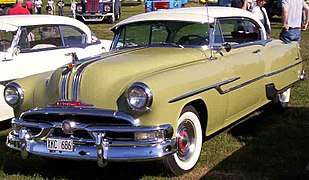 Pontiac Chieftain Catalina 1953
Pontiac Chieftain Catalina 1953 Pontiac Chieftain Catalina 1953
Pontiac Chieftain Catalina 1953 Pontiac Star Chief 1954
Pontiac Star Chief 1954 Pontiac Laurentian Convertible 1956
Pontiac Laurentian Convertible 1956 Pontiac Star Chief 1957
Pontiac Star Chief 1957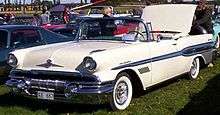 Pontiac Bonneville Convertible 1957
Pontiac Bonneville Convertible 1957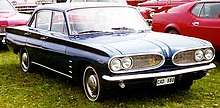 Pontiac 2119 Tempest 1961
Pontiac 2119 Tempest 1961 Pontiac GTO 1966
Pontiac GTO 1966- Pontiac Fiero 1988
 Pontiac Grand Am Sedan 1996–1998
Pontiac Grand Am Sedan 1996–1998 Pontiac Bonneville 2003
Pontiac Bonneville 2003 Pontiac Grand Prix GTP 2005
Pontiac Grand Prix GTP 2005 Pontiac GTO 2006
Pontiac GTO 2006 Pontiac G8 2008
Pontiac G8 2008
See also
- Category:Pontiac vehicles
- Pontiac V8 engine
- Pontiac Straight-8 engine
- Pontiac Straight-6 engine
- List of GM engines
- Pontiac, Michigan
- Pontiac (person)
Notes
- Niedermeyer, Paul (March 13, 2010). "An Illustrated History Of Pontiac: Part I – 1926 To 1970". The Truth About Cars. Retrieved June 25, 2015.
- "Pontiac". General Motors. Retrieved June 17, 2015.
- "Why Did GM Discontinue Pontiac?". Gmauthority.com. Retrieved June 17, 2015.
- Magazines, Hearst (April 1, 2001). Popular Mechanics. Hearst Magazines. p. 98. Retrieved September 2, 2018 – via Internet Archive.
Pontiac general motors Ottawa chief.
- "The Pontiac Automobile 1926-1932 & The Oakland Motor Car Co". American-automobiles.com. Retrieved September 2, 2018.
- Mason, Mark (September 2, 1992). American Multinationals and Japan: The Political Economy of Japanese Capital Controls, 1899-1980. Harvard Univ Asia Center. ISBN 9780674026308. Retrieved September 2, 2018 – via Google Books.
- Editors of Automobile Quarterly. General Motors: The First 75 Years. (New York: Crown Publishers, 1983), p.43.
- "Car Body Splits Wide Open to Show Engine and Interior". Popular Mechanics. 75 (1): 26. January 1941. Retrieved April 24, 2015.
- "1937 Pontiac Brochure". Oldcarbrochures.com. Retrieved April 24, 2015.
- "U.S. Auto Plants are Cleared for War". Life: 19. February 16, 1942. Retrieved April 24, 2015.
- "Golden Hills Mustang Club Wins Grand Prize In Eagle One Car Club Contest" (PDF). Archived from the original (PDF) on April 2, 2012. Retrieved September 2, 2018.
- "The Old Car Manual Project Brochure Collection". Oldcarbrochures.org. Retrieved October 22, 2019.
- "Amazing Radial Engine in Pontiac's Mini-Car." Popular Science, April 1969, pp. 63-65.
- Flory, J. "Kelly", Jr. American Cars 1960–1972 (Jefferson, NC: McFarland & Coy, 2004), p.854.
- The Standard Catalog of American Cars 1976-1999
- "Archived copy". Archived from the original on June 20, 2014. Retrieved May 27, 2014.CS1 maint: archived copy as title (link)
- ""GM Restructuring Plan for Long-Term Viability" (December 2, 2008)" (PDF). Freep.com. Retrieved October 12, 2010.
- Tutor, Chris (January 14, 2009). ""Official: GM shrinking to four brands; Pontiac to four models" from Autoblog (January 25, 2009)". Autoblog.com. Retrieved October 12, 2010.
- Tutor, Chris (December 15, 2008). ""Goodbye-amino? Pontiac could kill G8 ST; become one-car brand" From Autoblog (December 15, 2008)". Autoblog.com. Retrieved October 12, 2010.
- Green, Jeff (April 16, 2009). ""GM Said to Study Dropping Pontiac, GMC in Savings Bid (Update3)" From Bloomberg.com (April 16, 2009)". Bloomberg.com. Retrieved October 12, 2010.
- ""GM May Kill Pontiac, GMC Brands" From US News & World Report (April 16, 2009)". Usnews.rankingsandreviews.com. April 16, 2009. Retrieved October 12, 2010.
- Roth, Dan (April 16, 2009). ""REPORT: Pontiac and GMC may get axe... you knew this was coming" From Autoblog (April 16, 2009)". Autoblog.com. Retrieved October 12, 2010.
- Lavrinc, Damon (April 23, 2009). ""REPORT: General Motors to kill Pontiac on Monday" From Autoblog (April 23, 2004)". Autoblog.com. Retrieved October 12, 2010.
- Green, Jeff (April 24, 2009). ""GM Said to Preserve GMC Brand, Eliminate Pontiac in New Plan" (April 24, 2009)". Bloomberg.com. Retrieved October 12, 2010.
- Silke, Sharon (April 28, 2009). ""GM killing its Pontiac brand, sources say" From USA Today (April 27, 2009)". Usatoday.com. Retrieved October 12, 2010.
- Paukert, Chris (April 27, 2009). ""Officially Official: GM kills Pontiac (UPDATED with LIVE webcast embed)" From Autoblog.com (April 27, 2009)". Autoblog.com. Retrieved October 12, 2010.
- "Trademark Basics". Legalhelp.org. Retrieved June 17, 2015.
- "Article - WSJ.com". Online.wsj.com. April 27, 2009. Archived from the original on April 30, 2009. Retrieved May 2, 2009.
- Longley, Kristin (May 7, 2009). "Pontiac not for sale, GM says, despite local dealership's offer to buy". The Flint Journal. Retrieved October 24, 2012.
- "Pontiac hits end of the road after 82 years". Nbcnews.com. December 3, 2009. Retrieved October 5, 2014.
References
- Kimes, Beverly R. (1996). Clark, Henry A. (ed.). The Standard Catalog of American Cars 1805–1945. Krause Publications. ISBN 0-87341-428-4.
- Gunnell, John, ed. (1987). The Standard Catalog of American Cars 1946–1975. Krause Publications. ISBN 0-87341-096-3.
- Flammang, James; Kowalke, Ron (1999). The Standard Catalog of American Cars 1976–1999. Krause Publications. ISBN 0-87341-755-0.
External links
| Wikimedia Commons has media related to Pontiac. |
- Pontiac App on the App Store (All Diagnostic Trouble Codes & Car Dashboard Symbols)
- Pontiac at Curlie
- Forever Pontiac - The ONLY online Pontiac Enthusiast community
- Pontiac Portal at The Crittenden Automotive Library
- Classic Pontiac web site
- Pontiac web site from Switzerland
- Pontiac club English, Czech
- 1966 European export range from RitzSite
Further reading
- Jim Wangers; Glory Days: When Horsepower and Passion Ruled Detroit; Bentley Publishers (October 1998);
paperback: 348 pages, ISBN 0-8376-0208-4, ISBN 978-0-8376-0208-0; hardcover: 309 pages, ISBN 0-8376-0207-6, ISBN 978-0-8376-0207-3.